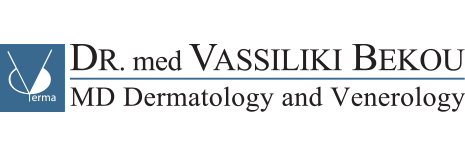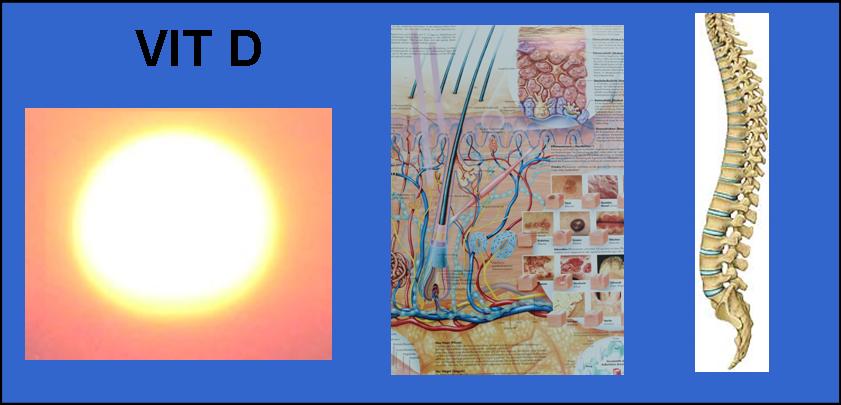Vitamin D
Approximately 80-90% of the needed vitamin D in the human organism is synthesized in the skin, and only about 10-20% is obtained from the diet.
The duration of the UV exposure, the area of the exposed skin area and the ratio of UVB (280-320 nm) to UVA radiation play a role in the formation of vitamin D in the skin.
In the skin is, however, under the influence of UV-B radiation also vitamin D is formed, which is present in the keratinocytes using the 25-hydroxylase and 1α-hydroxylase constantly converted into the active form, 1,25-dihydroxyvitamin D3.
Through the vitamin D, the activity of the immune system (T cells, dendritic cells) is reduced, so that many autoimmune diseases (arthritis, autoimmune thyroiditis, diabetes mellitus type I) will be improved.
For squamous cell carcinoma cumulative UV dose over the lifetime in the exposed skin area and for the basal cell carcinoma both the cumulative UV lifetime dose and intermittent higher dosed UV exposure are blamed.
For the development of malignant melanoma higher dose intermittent UV exposures in early childhood (0-6 years), with sunburns are responsible. Excessive UV exposure, especially UVB radiation with a wavelength 290-320 nm, thus constitutes an essential factor for the development of skin cancer.
Short-term and limited exposure to sunlight is sufficient to build adequate vitamin D levels. The exposure of about 18% of the body surface (z. B. hands, arms and face) 2 to 3 times / week in the summer and fall about 5 minutes for people with skin type II is sufficient. Prolonged exposure to sunlight sufficient sunscreen should always be applied in order to prevent sunburn and other harmful effects of excessive exposure to sunlight.
See:https://vbderma.com/blog/sun-and-sun-protection/
Vitamin D is a fat soluble vitamin and should be taken for food. Vitamin D promotes the absorption of calcium from the intestine are thus fitting into the bone. Calcium is the building material of the bone. In older people a lack of vitamin D leads due to an increased bone loss in osteoporosis, the child due to impaired bone development to rachitis. This ability of the skin to make the vitamin D itself is reduced with age. Consequence of the lack of vitamin D is insufficient calcium absorption in the intestine. This leads to a lowering of the blood calcium level. The body tries to compensate this and forms in the parathyroid glands the parathormon, which causes enhanced calcium releasion from the bone to offset the calcium blood level again. The resulting secondary hyperparathyroidism (overactive parathyroid gland) is the main cause of the so-called osteoporosis.
In addition to this function, vitamin D has mainly the elderly but yet another very important function. Vitamin D strengthens the muscle strength while promoting the neuromuscular coordination, that is the implementation of the nerve impulses to the muscle. The result is reduced inclination or fewer falls.
Calcium is an extremely important mineral and i.a. also a prerequisite for the entire muscular activity, both of the heart muscle and skeletal muscle (calcium-muscle pump) and, for example, the blood coagulation system. A deficiency of calcium and so of the body’s vital signs would be ensured through mobilization of the missing calcium from the bone. A calcium substitution can indeed avoid these redistribution for the period of the “cure” once it is but completed, the bone calcium is withdrawn again.
In Europe, partially higher reference values for children and adolescents are applied: infants (6-11 months): 10-25μg (400-1000 IU) per day, for over-70-year-old per day 15μg (600 IU). Vitamin D with 800IE / day without additional calcium intake leads to a reduction of bone fractures. Target are approximately 1000mg calcium intake / day. Is recommended 1 slice of hard cheese has 300mg calcium. It has been estimated that the daily intake of vitamin D3 in adults 1IE the 25 (OH) vitamin D3 in the blood increases by about 0.007 ng / ml (depending on the vitamin D status). It takes about 80 kg adult daily about 114 μg (4600 IU) of vitamin D3, a sufficient 25 (OH) vitamin D3 levels of 80 nmol / l = 32 ng/ml in the blood to keep the long term, unless no vitamin D formation by light is added.
Conclusion for practice
Vitamin D deficiency leads not only to an increased risk of diseases of bone and calcium metabolism, but is also associated with an increased risk of numerous other diseases such as various cancers, cardiovascular, infectious and autoimmune diseases. It is therefore important to ensure adequate vitamin D levels and in patients who apply UV protection, to substitute vitamin D orally.
Recommendations: no midday sun, keep in the shade, wearing protective clothing, and – a mass full UV exposure. Valuable are regular, but very moderate stays in the sun and, optionally, appropriate preventive measures that take account of the vitamin D status. “
( For the texts and pictures books, publications, guidelines for example in awmf.org and contributions of colleagues were consulted.)



